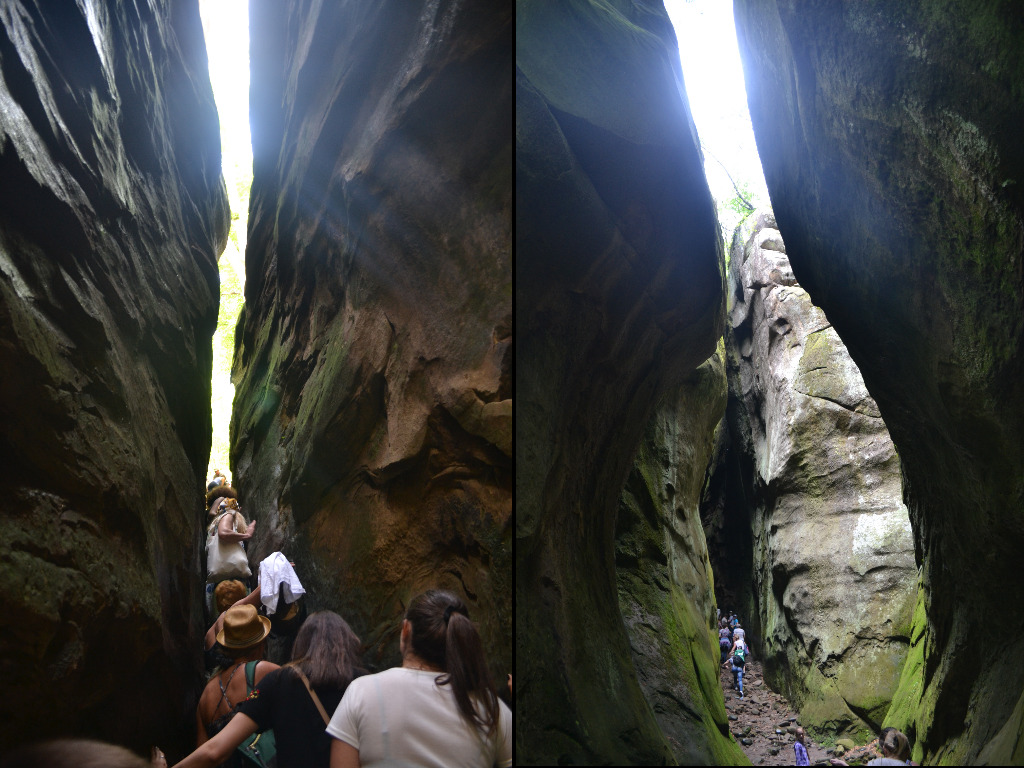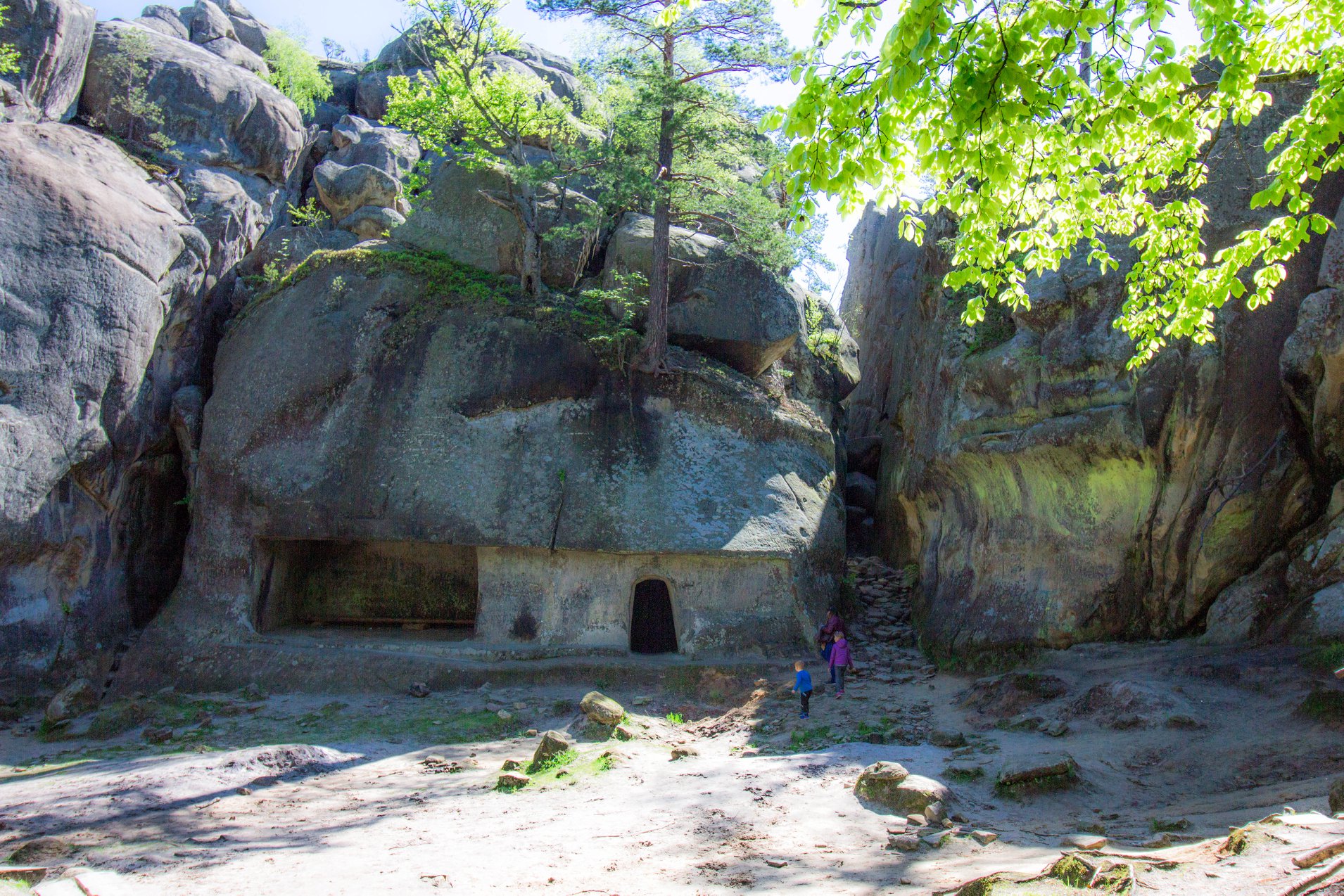In all religions of the world, rocks and stones play their part as symbols of indestructibility, power, and safety. Esoterics call prehistoric stone monuments ‘places of power’. It is believed that such places help recuperate life energy and look into the eyes of eternity.
Ukrainian Dovbush Rocks are considered to be one of these ‘places of power’. They are located on the border of the Ivano-Frankivsk region (near the town of Bolekhiv and the village of Bubnyshche) and Lviv region (near the village of Trukhaniv) and are considered almost the most mystical tourist attraction in the Carpathian region.
Here, surrounded by unusual volcanic stone giants that once sat at the bottom of the ancient sea, which is now replaced by an emerald forest, you will feel outside of the real world.
It would be impossible to tell all the incredible legends and mysteries about this ancient sanctuary, so let’s focus on the most widespread of them.
If you want to learn more and see this mysterious rock monument with your own eyes, we invite you to travel with Visit Ukraine Tour Operator and participate in the ‘Narrow-Gauge Railway in the Carpathians and Dovbush Rocks‘ tour with our experienced travel guides.

History of Dovbush Rocks
A natural monument of national importance since 1981, the botanical and geomorphological reserve “Dovbush Rocks” covers an area of 100 hectares and has a height of 50 m. It consists of stone massifs and towers of gray sandstone, set against the background of forest lace, which had been formed 70 million years ago.
Researchers assume that the history of the rocks is connected with the Celtic tribes that inhabited the Carpathians in the first millennium BC and worshiped the great stones. As Christianity was becoming more widespread, the former pagan sanctuary with altars was turned into a cave monastery.
You may also be interested in the ‘Around the Carpathians in 7 days’ tour from Lviv.
During the medieval wars for ownership of the Carpathians, the rock massif was used as an impregnable fortress, which withstood many attacks of Polish and Mongol-Tatar troops. Later, the rocks became part of the hunting field of the Potocki princes.
In the 17-18th centuries, the rocks served as a secret shelter for members of the insurgent movement of opryshky – rural rebels who fought against serfdom and feudal lords’ oppression.
It is in honor of one of the leaders of the movement Oleksa Dovbush, a legendary figure of the Hutsul region, that this attraction was named Dovbush Rocks during Soviet times. In the 19th century, the rocks attracted a lot of attention from researchers and mystics. In our times the rock complex became widely popular among tourists and climbers.
Traveling to the rocks

Tourists explore the rocks in the crescent-shaped Main Massif encircled by a moat, with the inner area, caves of precise geometric shapes, remains of the well, and stone ladders, and the remains of a defensive rampart.
The main massif is surrounded by boulders – real natural wonders that have not been touched by human hands. A skilled sculptor, nature, with the help of primordial tools – wind, rain, and sun – sculptured the inquisitive giant named Kolobok, carved a graceful Tulip, sculpted a feminine Doll, created a Book as high as two humans. The Witch massif, the giant Sail, the Armor, the Shurshun evoke associations even in people who lack imagination.

Some rocks have been awarded very peculiar names – here you can find “Kiss of the Doggo”, “Suitcase of Salvador Dali”, “Space Intruders”, “Jolly Roger”, “The Grumbling of the Lambs” and other, sometimes not even very polite nicknames.
Walking through the Dovbush Rocks, do not miss the opportunity to placate the Forest Lord carved on the Dragon’s Tail, to climb through the Limbo crevice that’s only 22 cm wide (if, of course, your sins can fit it), to unravel ancient and modern “petroglyphs”, see the stone ear and heart of Oleksa Dovbush and admire the magnificent panorama of the Carpathian Mountains from the top of the rocks.

Legends of the Dovbush Rocks
Bubnyshche village, where the rocks are located, has many related legends that differ from each other. Some people claim that the name comes from the fact that the peasants began to beat the tambourine (bubon in Ukrainian) when the Tatar hordes approached the village. A more poetic legend tells about a girl who was the only villager to survive the Tatar attack and hid in the rocks, warning of danger with a tambourine.
Many folk tales associate the rock complex with Oleksa Dovbush, who was rumored to have had a magical power that needed to be restored among the rocks. The story of the death of the opryshky leader comes up in various sources. Oleksa was mortally wounded by the husband of his former lover Dzvinka, who was turned into a rock for her betrayal. And the body of Dovbush was dismembered and scattered throughout the Carpathians, so the Bubnyshche complex is not the only Dovbush Rocks in the Carpathian Mountains.
And also there are rumors that the stone giants are guarding a mysterious cave with Oleksa Dovbush’es gold hoard, and it will be opened only to those who know the magic word. Let’s try?

Interesting Facts about Dovbush Rocks
- One of the greatest poets of Ukraine, Ivan Franko, repeatedly visited the Dovbush rocks and even dedicated several poems to this unique monument;
- Polish military map of 1935 illustrates Dovbush rocks as the Bubnyshche Rock Reserve, which confirms the existence of the reserve as early as the 1930s.
- Similar rocks with the same name exist in the town of Yaremche (also Ivano-Frankivsk region), so do not confuse them!
- You can get to the rocks both from Ivano-Frankivsk (via Bolekhiv-Bubnyshche) and from Lviv regions (via Nyzhne Synovidne – Trukhaniv).
If you want to learn about the image of a lion on one of the rocks, about the purpose of man-made caves, if you want to pass the test of Limbo, ride around the rocks on horseback, then join our tour ‘Narrow-Gauge Railway in the Carpathians and Dovbush Rocks‘. Fantastic giants will reveal their secrets to you and steal your heart away with their cosmic energy.
Additional Information
Location: near the village of Bubnyshche, Ivano-Frankivsk region, and Trukhaniv village of Lviv region.
Coordinates: GPS 49°2’40”N, 23°40’52”E
Entrance fee: fee for admission of an automobile – 30 UAH.
You can visit Dovbush Rocks on these trips:
- Around the Carpathians in 7 Days (7 days / 6 nights);
- Carpathian Narrow-Gauge Railway and Dovbush Rocks (1 day).






